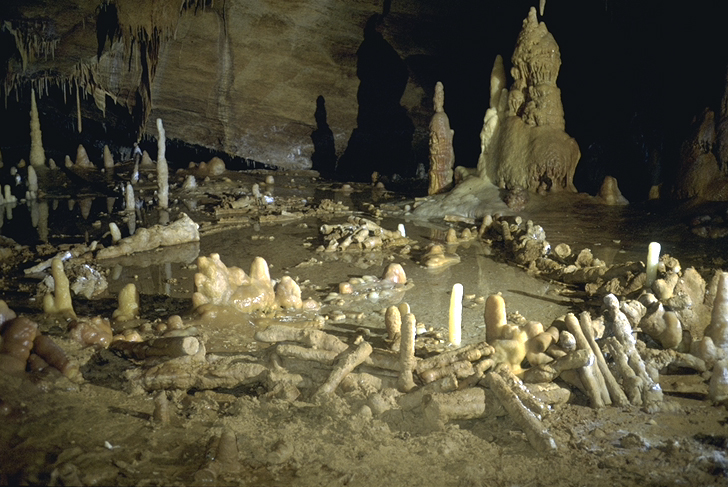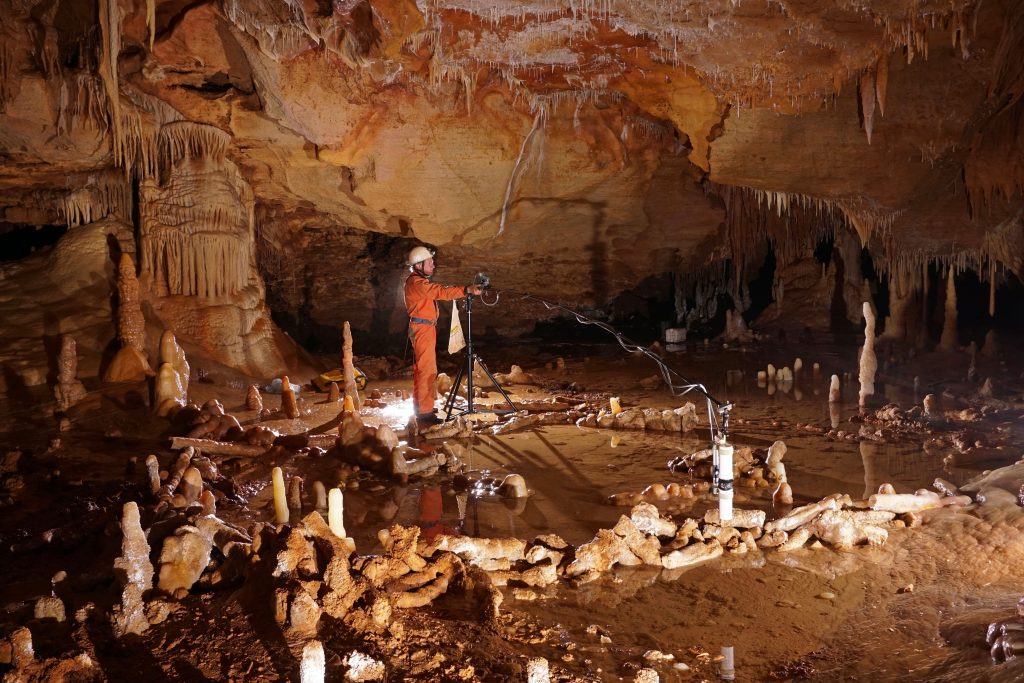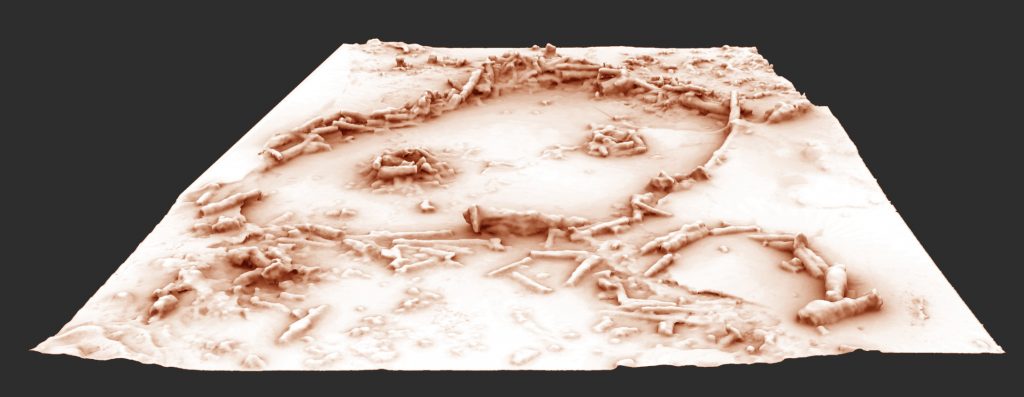
New dating evidence has confirmed that Neanderthal man made their way deep into caves in France and created complex structures from broken stalagmites and stalactites.
Bruniquel cave in the Tarn-et-Garonne region of southern France was discovered and first explored in 1990. A challenging 30m entrance series leads to larger, well-decorated passages containing animal bones and evidence of occupation by bears, including hibernation pits and claw marks on the walls, which anyone who has visited the showcave of Rouffignac in the Dordogne will be familiar with.
336m into the cave, the original explorers found a large chamber where in the region of 400 stalagmites and stalactites had been deliberately broken off and arranged into two large rings on the floor of the passage, with the broken pieces piles up on each other to make low, layered walls. Other broken pieces had been stacked up nearby in four piles. In all, a staggering total of 112 metres of stalagmites have been broken into well-calibrated pieces, weighing an estimated 2.2 metric tons. The chamber also contains traces of fire and burnt bones.

Caver and archaeologist François Rouzaud, at the time chief heritage curator of the Midi Pyrénées, was brought in to advise and samples of burnt bear bone were taken for radio carbon dating. The results indicated that the bone was in the region of 47,600 years old. This meant that the structures pre-dated the rise of modern man (Homo sapiens sapiens) and therefore had to be the work of Neanderthal man, the only early humans in the region at that time. Unfortunately, in 1999, Rouzaud died underground in Foissac, in the Lot, and work on Bruniquel ceased.
Recently, Sophie Verheyden, a caver and stal dating specialist from the Royal Belgian Institute of Natural Sciences visited the region and her interest in the site was aroused when she saw a display at a nearby castle and realised the site’s potential. The dates obtained by Rouzaud were close to the limit of the accuracy of radio carbon dating, so Verheyden had the idea of dating the broken stal itself, by using uranium series techniques. A team was assembled, including fellow dating specialist Dominique Gentry from the CNRS (Centre national de la recherche scientifique) and archaeologist Jacques Jaubert from the University of Bordeaux.

In 2013, they obtained permission to study the site and were able to take samples from the broken stal. By dating the end of the growth of the stalagmites used in the structures and the beginning of the re-growth sealing those same structures, the researchers were able put a date on when the breakage had occurred.
The date of 176,500 years ago that came back from the samples astounded everyone.
Their paper published in the scientific journal Nature, states: “Uranium-series dating of stalagmite regrowths on the structures and on burnt bone, combined with the dating of stalagmite tips in the structures, give a reliable and replicated age of 176.5 thousand years (±2.1 thousand years), making these edifices among the oldest known well-dated constructions made by humans.”
The presence of these structures so deep into the cave indicate that Neanderthals had the ability to penetrate deep cave environments, a considerable achievement even by itself, but when coupled with the fact that they then broke off numerous stalagmites and stalactites and constructed these rings, the story becomes even more remarkable.
Darkness Below approached experts in the field for their comments on the latest work in Bruniquel.
Jean Clottes, the now retired Scientific Advisor for prehistoric rock art at the French Ministry of Culture, first saw the cave and its structures more than 20 years ago when the cave was discovered. He told us: “The new date is very ancient, far more than one would have thought, but the fact that the stone structures had been built by Neanderthals deep inside the cave was established right from the start when the discoverers got a radiocarbon date of “more than 47,600BP” from a bone. The consequences were then published and repeated in various articles since (i.e. Neandertals going deep inside a cave and building stone structures that do not seem to have any practical function).”

In an article written at the time, Clottes notes: “One is an oval (5m by 3.5m) and the other is a circle (1.5m in diameter). In the bigger one, a small fire included a fragment of bear bone that had been burnt not long after the death of the bear, as the bone was still fresh at the time of burning.” The latest study has included a 3d laser scan of the structures enabling them to be studied in detail outside the cave.
New work, studying magnetic fields has been used to reveal anomalies caused by heat, making it possible for the scientists now working in the cave to map the burnt remnants found in this area. The team believe the most plausible explanation is that these fires were simply used as light sources.

The new dating evidence confirms beliefs that Neanderthals were capable of complex thought processes and behaviour. Professor Joao Zilhao of the Department of Prehistory, Ancient History and Archaeology at the University of Barcelona told us that he fuly agrees with the new interpretations and conclusions. He says: “What this evidence does for the Neandertals is bring additional support for their “behavioural modernity” and fully human “status” as a regional variant or “race” of Homo sapiens, as otherwise implied by the archeological, paleontological and genetical evidence accumulated over the past two decades.”
UK expert Professor Chris Stringer, Research Leader in Human Origins at the Natural History Museum told us that there are examples of human habitation 30 or 40 metres into the dark zones of caves from sites of similar or even greater age in Africa, but he points out that ”… the Bruniquel structures are some ten times deeper into the cave and are constructions as complex as some made by modern humans only 20 or 30,000 years again.”
As yet, there is no archaeological evidence to tell us what the purpose of the structures might have been, but future excavations in the cave floor might well yield new information. Chris Stringer says: “If there is still-buried debris from occupation, it would help us to determine whether this was a functional refuge or shelter, perhaps roofed using wood and skins, or something which had more symbolic or ritual significance.”
Dr David Richards, Senior Lecturer in the University of Bristol School of Geographical Sciences and member of the Bristol Isotopes Group had this to say about the dating work: “This is a most intriguing find and an excellent example of how uranium-thorium ages can be used to provide constraints for the timing of event by proving maximum and minimum ages. It is always challenging in cave environments to get clean material near a hiatus in growth; here represented by the repositioning of broken stalagmites and subsequent re-precipitation of calcite. The consistent ages obtained for the youngest material in the construction and the oldest material deposited after completion provide tight constraints. Hai Cheng and Larry Edwards (Univ. Minnesota) have the best track record in the world for U-Th dating, which is the ideal method in cave settings beyond the limits of radiocarbon dating to a maximum of approximately 500,000 years.”
But for now, their purpose remains a matter of conjecture. What is known is that Neanderthals had the knowledge and skill to enable them to penetrate deeply into the dark zone of caves, making and transporting fire with them, either singly or – more likely – in groups. The structures are not simply the result of random breakages. They had a reason for doing what they did, and maybe, in time, further research will shed light on what that might have been.
Anyone interested in reading more might find this link useful – http://johnhawks.net/weblog/reviews/neandertals/culture/jaubert-bruniquel-stone-circles-2016.html
Correspondent: Linda Wilson
